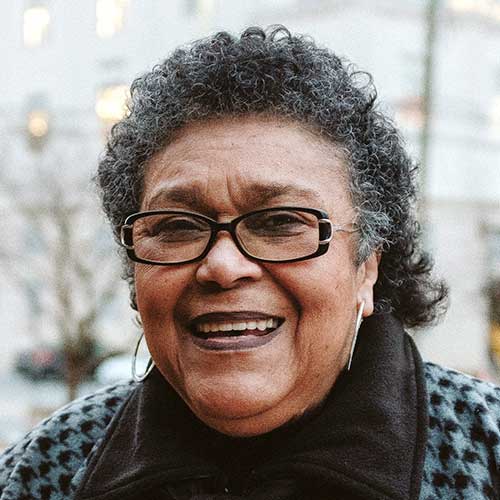2001
2001
PHA buys Garrett Square
Description
- Piedmont Housing Alliance and the National Housing Trust pledge to buy and renovate Garrett Square for $9.2 million ($5.5 million for the property; $2.3 million for renovations). They plan to use more than $3 million in tax credits.
- Charlottesville Mayor Blake Caravati expresses his desire for the vacant green space between Friendship Court residences and Sixth Street Southeast to be developed into “mixed-income” housing.
- Residents continue fighting to have the remaining 7-foot tall metal fence that surrounds the neighborhood taken down, saying that it is “a humiliation” and has made residents feel “like animals, trapped.” PHA says it will take down the fence, if that’s what residents want.
- The Daily Progress publishes an editorial about Garrett Square, calling out the surrounding city for wrongfully “stigmatizing them as the source of crime” in their own neighborhood.
- In June, Tenant Association president Mary Carey and fellow residents throw a giant block party to get people to see “a different side of Garrett.”
Quote
It was built in ’78 and this is 2001. Do I have to say any more? That’s a long time to go without having things checked that’s important. If you can live through renting from these folks, you can live through everything.
— Mary Carey, president of the Garrett Square Tenant Association
People
What are the fondest memories you have of Garrett Square?
The Reimagining of Friendship Court
INTRO
By
Jordy Yager
The redevelopment of Friendship Court is slated to be the largest new construction of low-income housing undertaken in Charlottesville in more than two decades. The plan alone is groundbreaking, having been directly created by current Section 8 residents in partnership with Piedmont Housing Alliance. City staff calls it the most nuanced and complex plan they’ve ever encountered. It ambitiously attempts to balance promises of zero resident displacement with the city’s broader affordable housing needs, while also calling for hundreds of new, likely higher-income, residents to move in, as residents hope to de-stigmatize the lasting effects of poverty born out of generations of racist government policy and neglect.
This year will be the make-or-break year for Friendship Court’s redevelopment efforts. Millions of dollars in city, federal, and private funding stand between the massive plan and the highly anticipated 2020 groundbreaking. And while the green lights have begun to align and most residents are excited, the plan has its critics — those who call for greater levels of resident autonomy, greater security measures to guard against social and cultural displacement, and greater reparations for past wrongs.
In crafting this project, we’ve tried to tackle all of this and more by separating the longer narratives into five major questions:
Part 1: What is the plan?
Part 2: How did we get here?
Part 3: Does mixed-income housing work?
Part 4: Who does Friendship Court belong to?
Part 5: What’s next?
But we also wanted to give you access to as much of our reporting as possible, so we’ve created a timeline that details the history of this area, dating back 150 years, through the use of more than 130 maps, documents, archived articles, and photographs. Similarly, we wanted you to actually hear each of the two dozen long-form interviews we conducted, and not merely the portions we’ve included in the individual stories. So we’ve included more than 300 audio clips throughout the story: in the articles, the timeline, and on each person’s profile page. Our hope is that with all this, more of the picture will begin to emerge, and that, as we stand ready to make powerful and significant changes in the city, we all can help craft the solutions.
The redevelopment of Friendship Court is slated to be the largest new construction of low-income housing undertaken in Charlottesville in more than two decades. The plan alone is groundbreaking, having been directly created by current Section 8 residents in partnership with Piedmont Housing Alliance. City staff calls it the most nuanced and complex plan they’ve ever encountered. It ambitiously attempts to balance promises of zero resident displacement with the city’s broader affordable housing needs, while also calling for hundreds of new, likely higher-income, residents to move in, as residents hope to de-stigmatize the lasting effects of poverty born out of generations of racist government policy and neglect.
This year will be the make-or-break year for Friendship Court’s redevelopment efforts. Millions of dollars in city, federal, and private funding stand between the massive plan and the highly anticipated 2020 groundbreaking. And while the green lights have begun to align and most residents are excited, the plan has its critics — those who call for greater levels of resident autonomy, greater security measures to guard against social and cultural displacement, and greater reparations for past wrongs.
In crafting this project, we’ve tried to tackle all of this and more by separating the longer narratives into five major questions:
Part 1: What is the plan?
Part 2: How did we get here?
Part 3: Does mixed-income housing work?
Part 4: Who does Friendship Court belong to?
Part 5: What’s next?
But we also wanted to give you access to as much of our reporting as possible, so we’ve created a timeline that details the history of this area, dating back 150 years, through the use of more than 130 maps, documents, archived articles, and photographs. Similarly, we wanted you to actually hear each of the two dozen long-form interviews we conducted, and not merely the portions we’ve included in the individual stories. So we’ve included more than 300 audio clips throughout the story: in the articles, the timeline, and on each person’s profile page. Our hope is that with all this, more of the picture will begin to emerge, and that, as we stand ready to make powerful and significant changes in the city, we all can help craft the solutions.





